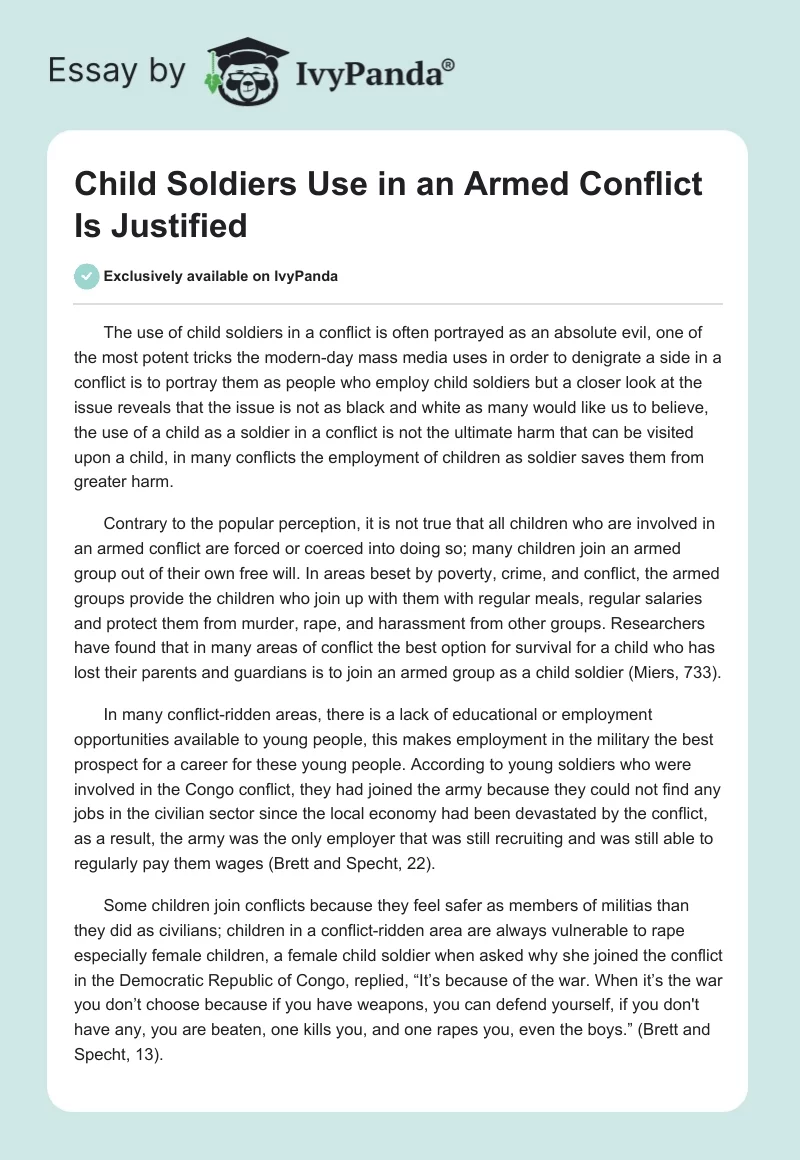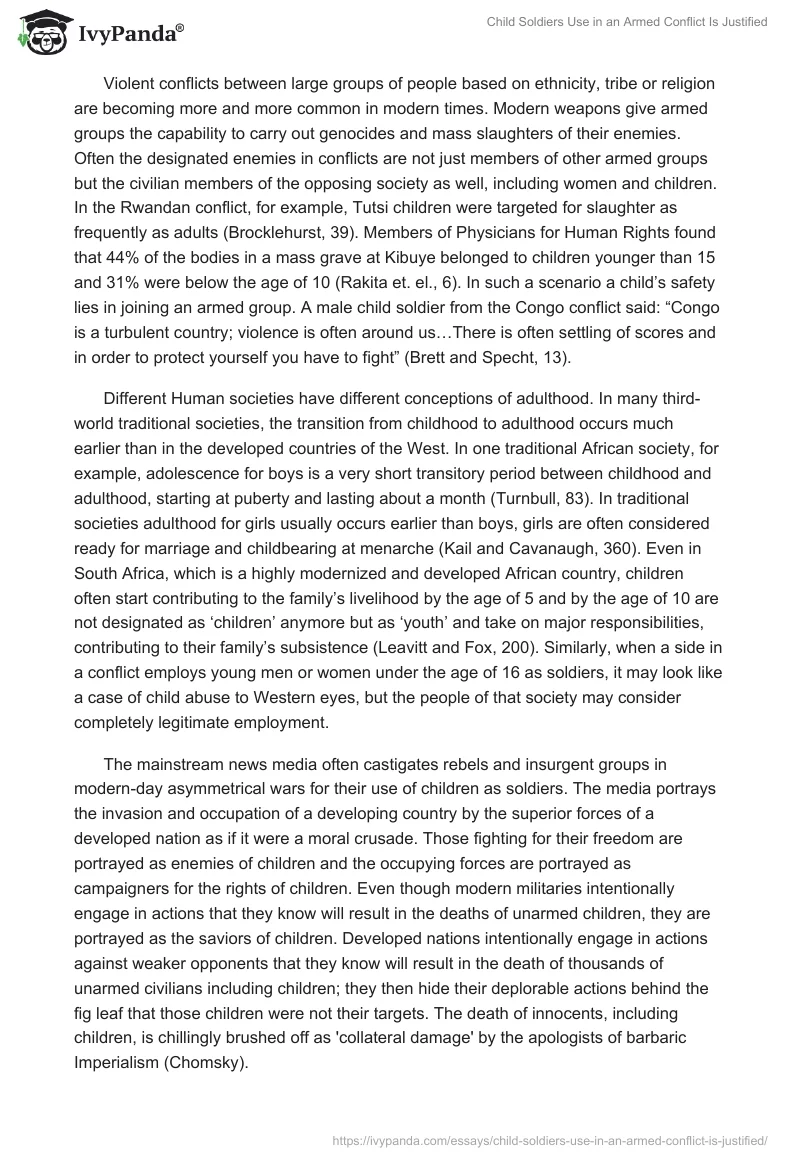The use of child soldiers in a conflict is often portrayed as an absolute evil, one of the most potent tricks the modern-day mass media uses in order to denigrate a side in a conflict is to portray them as people who employ child soldiers but a closer look at the issue reveals that the issue is not as black and white as many would like us to believe, the use of a child as a soldier in a conflict is not the ultimate harm that can be visited upon a child, in many conflicts the employment of children as soldier saves them from greater harm.
Contrary to the popular perception, it is not true that all children who are involved in an armed conflict are forced or coerced into doing so; many children join an armed group out of their own free will. In areas beset by poverty, crime, and conflict, the armed groups provide the children who join up with them with regular meals, regular salaries and protect them from murder, rape, and harassment from other groups. Researchers have found that in many areas of conflict the best option for survival for a child who has lost their parents and guardians is to join an armed group as a child soldier (Miers, 733).
In many conflict-ridden areas, there is a lack of educational or employment opportunities available to young people, this makes employment in the military the best prospect for a career for these young people. According to young soldiers who were involved in the Congo conflict, they had joined the army because they could not find any jobs in the civilian sector since the local economy had been devastated by the conflict, as a result, the army was the only employer that was still recruiting and was still able to regularly pay them wages (Brett and Specht, 22).
Some children join conflicts because they feel safer as members of militias than they did as civilians; children in a conflict-ridden area are always vulnerable to rape especially female children, a female child soldier when asked why she joined the conflict in the Democratic Republic of Congo, replied, “It’s because of the war. When it’s the war you don’t choose because if you have weapons, you can defend yourself, if you don’t have any, you are beaten, one kills you, and one rapes you, even the boys.” (Brett and Specht, 13).
Violent conflicts between large groups of people based on ethnicity, tribe or religion are becoming more and more common in modern times. Modern weapons give armed groups the capability to carry out genocides and mass slaughters of their enemies. Often the designated enemies in conflicts are not just members of other armed groups but the civilian members of the opposing society as well, including women and children. In the Rwandan conflict, for example, Tutsi children were targeted for slaughter as frequently as adults (Brocklehurst, 39). Members of Physicians for Human Rights found that 44% of the bodies in a mass grave at Kibuye belonged to children younger than 15 and 31% were below the age of 10 (Rakita et. el., 6). In such a scenario a child’s safety lies in joining an armed group. A male child soldier from the Congo conflict said: “Congo is a turbulent country; violence is often around us…There is often settling of scores and in order to protect yourself you have to fight” (Brett and Specht, 13).
Different Human societies have different conceptions of adulthood. In many third-world traditional societies, the transition from childhood to adulthood occurs much earlier than in the developed countries of the West. In one traditional African society, for example, adolescence for boys is a very short transitory period between childhood and adulthood, starting at puberty and lasting about a month (Turnbull, 83). In traditional societies adulthood for girls usually occurs earlier than boys, girls are often considered ready for marriage and childbearing at menarche (Kail and Cavanaugh, 360). Even in South Africa, which is a highly modernized and developed African country, children often start contributing to the family’s livelihood by the age of 5 and by the age of 10 are not designated as ‘children’ anymore but as ‘youth’ and take on major responsibilities, contributing to their family’s subsistence (Leavitt and Fox, 200). Similarly, when a side in a conflict employs young men or women under the age of 16 as soldiers, it may look like a case of child abuse to Western eyes, but the people of that society may consider completely legitimate employment.
The mainstream news media often castigates rebels and insurgent groups in modern-day asymmetrical wars for their use of children as soldiers. The media portrays the invasion and occupation of a developing country by the superior forces of a developed nation as if it were a moral crusade. Those fighting for their freedom are portrayed as enemies of children and the occupying forces are portrayed as campaigners for the rights of children. Even though modern militaries intentionally engage in actions that they know will result in the deaths of unarmed children, they are portrayed as the saviors of children. Developed nations intentionally engage in actions against weaker opponents that they know will result in the death of thousands of unarmed civilians including children; they then hide their deplorable actions behind the fig leaf that those children were not their targets. The death of innocents, including children, is chillingly brushed off as ‘collateral damage’ by the apologists of barbaric Imperialism (Chomsky).
In the eyes of the imperialist forces, the lives of children in poor countries are not worth anything; this can be seen in the response of former US Ambassador to the United States Madeline Albright, when she was asked regarding the death of half a million Iraqi children as a result of US-imposed sanctions, she replied that it was “worth it” (Pilger, 64). From this, we can see that the concern expressed by the governments and the media of developed countries at the use of children as soldiers in armed conflict is a mere propaganda tool to demonize those who have the courage to resist their onslaught since these governments and media rarely display any concern at the much greater harm their own side inflicts upon the children of enemy countries. In such conflicts children may feel that proactively engaging in war against the occupying forces is better than sitting around in fear of the bombs and missiles falling around them and to die fighting for freedom is better than ending up as ‘collateral damage.
In modern-day conflicts, groups of rebels and paramilitary organizations associated with one community or the other are more likely to resort to the use of child soldiers than regular armies. The main reason behind the formation of paramilitary groups or militias and the start of insurgencies and rebellions is often government incompetence or state-based oppression. The weaker side in a conflict is usually the one that is forced to employ even children as soldiers for the survival and protection of their community. Given the brutal realities of war in the modern age, enlisting as a soldier may even be in the best interest of a child.
References
Brett, Rachel and Specht, Irma Young soldiers: why they choose to fight. Boulder, CO: International Labour Organization, 2004.
Brocklehurst, Helen Who’s afraid of children?: children, conflict and international relations. Surrey, UK: Ashgate Publishing, 2006.
Chomsky, Noam The World’s Most Wanted. 2008. Web.
Kail, Robert V. and Cavanaugh, John C. Human Development: A Life-Span View. Boston, MA: Cengage Learning, 2008.
Leavitt, Lewis A. and Fox, Nathan A. The Psychological effects of war and violence on children. Mahwah, NJ: Lawrence Erlbaum, 1993.
Miers, Suzanne “Contemporary Forms of Slavery.” Canadian Journal of African Studies (2000): 714-747.
Pilger, John The new rulers of the world. London, UK: Verso Books, 2003.
Rakita, Sara; Des Forges, Alison; McClintock, Michael; Thonden, Yodon; Hiddleston, Trish; Parekh, Vikram Lasting wounds, consequences of genocide and war on Rwanda’s children. New York, NY: Human Rights Watch, 2003.
Turnbull, Colin M. The human cycle. New York, NY: Simon & Schuster, 1984.


